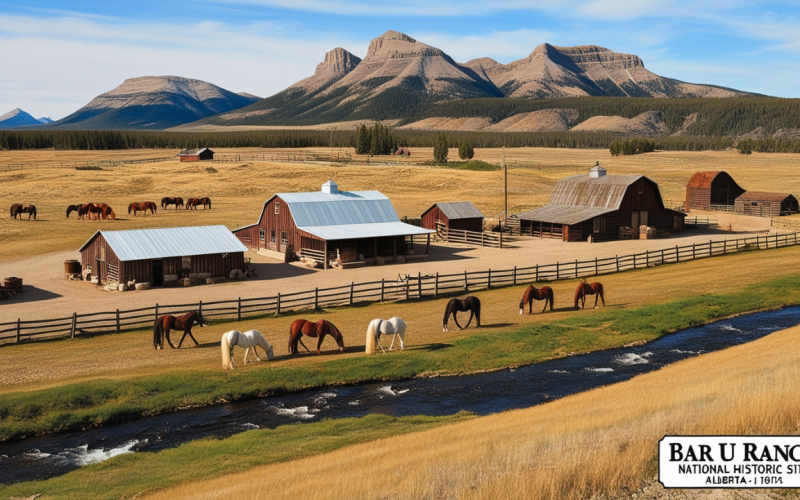Intro about Bar U Ranch National Historic Site (Alberta)
Bar U Ranch National Historic Site (Alberta) is a cornerstone of Canada’s ranching history. Located in southern Alberta, along the picturesque foothills of the Rocky Mountains, it preserves a way of life that shaped the Canadian West. Established in 1882, this ranch tells the story of the hardworking individuals who built Canada’s ranching industry from the ground up.
Today, Bar U Ranch offers visitors an immersive experience of the world of cowboys, cattle, and Percheron horses. Whether you’re exploring the blacksmith shop, learning about historic ranching techniques, or marveling at the breathtaking natural landscape, you’re stepping into a living history that reflects the resilience and ingenuity of early ranchers.
Key Takeaways
- Bar U Ranch showcases Canada’s ranching history and culture.
- Established in 1882, it played a crucial role in the development of Alberta’s ranching industry.
- It preserves historic buildings, traditional ranching techniques, and natural landscapes.
- Visitors can engage in activities that bring the past to life, such as running demonstrations and tours.
- Bar U Ranch is a must-see destination for anyone seeking a connection to Canada’s rural heritage.
The Founding of Bar U Ranch
A Pioneer Ranch Established in 1882
The Bar U Ranch began its story as a large-scale cattle operation during a period of rapid expansion in the ranching industry. Its fertile location along Pekisko Creek and proximity to the Rocky Mountains made it ideal for raising cattle and horses. The ranch became one of the most successful in Canada, shaping the economy and culture of the region.
Visionary Leaders and Builders
The ranch owes much of its early success to visionary figures like George Lane and Patrick Burns. Lane, a well-known cattleman, brought innovative management practices that made the ranch thrive. Burns, a businessman and ranching enthusiast, expanded its operations, securing its place in Canada’s agricultural history.
The Role of Bar U Ranch in the Ranching Industry
Bar U’s Influence on Canadian Ranching
As one of the first large-scale ranches in Canada, Bar U Ranch became a hub for innovation and growth in the ranching industry. It demonstrated advanced cattle-breeding techniques, ranching skills, and the efficient use of rangelands. Its influence extended far beyond Alberta, setting standards for ranches across the country.
Breeding Excellence with Percheron Horses
The ranch was also a leader in breeding Percheron horses, known for their strength and versatility. These horses were essential for heavy work, such as pulling wagons and plows, making them an indispensable part of ranching life.
Life at Bar U Ranch
H3: A Day in the Life of a Cowboy
Life at Bar U Ranch was demanding but rewarding. Cowboys worked from dawn to dusk, managing cattle, maintaining equipment, and performing tasks like branding and roping. The ranch’s culture was built around hard work, teamwork, and the deep connection between people and the land.
The Heart of the Ranch: Its Buildings
Bar U Ranch’s historic buildings tell the story of life on the range:
- The barn serves as a central hub for livestock management.
- The cookhouse was the gathering place where workers shared meals and stories.
- The blacksmith shop provided essential tools and repairs, ensuring the smooth operation of the ranch.
These structures remain well-preserved, offering visitors a tangible link to the past.
Exploring the Landscape of Bar U Ranch
A Natural and Cultural Blend
Bar U Ranch’s landscape is a seamless blend of natural beauty and human ingenuity. Its native vegetation, including fescue grass and cottonwood trees, frames the historic buildings, creating a setting that reflects both the ruggedness and harmony of ranching life.
Pekisko Creek and the Surrounding Foothills
The ranch is situated along Pekisko Creek, with its waters providing life to the cattle and crops. The surrounding foothills, ringed by the majestic Rocky Mountains, form a natural boundary, emphasizing the vastness and isolation of early ranching life.
Preservation of Open Spaces
The ranch’s open rangelands, used for cattle grazing, are a defining feature of the property. These vast, unenclosed spaces remain a symbol of the ranch’s enduring rural character and its connection to the Canadian West.
Key Features of Bar U Ranch Landscape
| Feature | Significance |
| Pekisko Creek | Water source and central feature of the ranch. |
| Rocky Mountain Foothills | Natural boundary offering protection and scenic views. |
| Native Fescue Grass | Vital for cattle grazing and maintaining biodiversity. |
| Open Rangelands | Essential for cattle herding and large-scale operations. |
Preserving the Heritage of Bar U Ranch
A National Historic Site of Canada
Designated as a National Historic Site in 1989, Bar U Ranch represents a vital chapter in Canada’s history. Its preservation ensures that future generations can learn about the challenges and triumphs of ranching life.
Parks Canada’s Role
Parks Canada has been instrumental in maintaining the ranch’s cultural landscape, including its natural vegetation and historic structures. Their efforts focus on balancing historical accuracy with visitor engagement, creating an immersive experience for all.
Visitor Experience at Bar U Ranch
Interactive Activities
Bar U Ranch offers hands-on experiences that bring history to life:
- Visitors can practice ranching techniques like roping and cattle handling.
- The blacksmith shophosts demonstrations of traditional forging skills.
Around the Campfire
The ranch’s campfire sessions provide a glimpse into the social side of ranch life, with storytelling, songs, and camaraderie reminiscent of a cowboy’s evenings under the stars.
Interpretive Tours
Guided tours take visitors through the ranch’s historic buildings, providing insights into the lives of the people who lived and worked there.
Alberta’s Ranching Legacy
Bar U’s Lasting Impact
Bar U Ranch is a symbol of Alberta’s pioneering spirit. Its contributions to the ranching industry in Canada helped shape the province’s identity, ensuring that the traditions and values of ranching continue to thrive.
Connection to Cowboy Culture
The ranch embodies the essence of cowboy life, from its open rangelands to its hardworking community. This connection to cowboy culture makes it a unique and meaningful destination for visitors.
Visitor Highlights at Bar U Ranch
| Activity | Experience |
| Ranching Demonstrations | Practice roping and learn cattle-handling techniques. |
| Percheron Horse Viewing | See these majestic animals in action. |
| Blacksmith Shop Visits | Watch traditional forging techniques. |
| Campfire Stories | Experience cowboy culture with stories and songs. |
Planning Your Visit to Bar U Ranch
Getting There
Bar U Ranch is located just south of Calgary, near Longview, Alberta. Its proximity to major cities makes it an accessible day trip or weekend destination.
What to Expect
- A blend of education, entertainment, and outdoor adventure.
- Opportunities to explore Alberta’s rich natural and cultural heritage.
Bar U Ranch’s Evolution Over Time
From a Working Ranch to a Historical Landmark
Bar U Ranch started as a working ranch in 1882 and evolved into a cornerstone of Canada’s cultural heritage. For decades, it operated as a cattle ranch, helping to shape the agricultural economy of southern Alberta. Over time, as industrialization and urbanization grew, the ranch transitioned from a private enterprise into a historical site preserved by Parks Canada. This shift ensured that future generations could witness the evolution of ranching life in Canada.
Milestones in Bar U Ranch’s History
- 1882: Bar U Ranch is founded, becoming a vital part of the burgeoning ranching industry.
- 1900s: Under the ownership of Patrick Burns, it reaches its peak as a cattle and horse breeding powerhouse.
- 1989: The ranch is officially designated a National Historic Site of Canada.
- Today: Bar U Ranch serves as a living museum, showcasing ranching traditions and Alberta’s rural past.
The Architecture of Bar U Ranch
Vernacular Construction Techniques
The buildings at Bar U Ranch reflect practical, functional designs typical of the 19th century. Using materials sourced locally, such as timber and stone, the ranch’s structures were built to endure harsh Alberta winters and the daily demands of ranching life. The simplicity of these designs, combined with their adaptability, speaks to the ingenuity of early ranchers.
Key Structures at the Ranch
- The Barn: Central to the ranch’s operations, it housed livestock and stored feed and equipment.
- The Cookhouse: A communal gathering space where meals were prepared and workers connected.
- The Blacksmith Shop: Essential for crafting tools and shoeing horses, this shop ensured the ranch ran smoothly.
Bar U Ranch’s Impact on the Ranching Industry
Innovations in Cattle and Horse Breeding
Bar U Ranch was a pioneer in breeding Percheron horses, valued for their strength and resilience. These horses were instrumental in ranch work, pulling wagons, plows, and other heavy loads. The ranch also excelled in cattle breeding, improving herd quality and setting standards for ranching across Alberta.
Influence Beyond Alberta
The techniques and practices developed at Bar U Ranch spread across Canada, influencing the ranching industry from coast to coast. Its success demonstrated how innovation and adaptability could transform the agricultural landscape, setting the stage for modern ranching.
Daily Life at Bar U Ranch
A Cowboy’s Routine
Life at Bar U Ranch revolved around hard work, discipline, and resilience. Cowboys spent their days herding cattle, mending fences, and performing tasks like branding and roping. Nights often ended around a campfire, where camaraderie and storytelling became a cherished part of ranch life.
Social Life on the Ranch
Despite the demanding work, ranchers found moments of connection and celebration. The cookhouse served as a social hub, where workers shared meals and built friendships. Seasonal events, such as cattle roundups, brought the community together, fostering a sense of unity.
The Natural Environment of Bar U Ranch
The Importance of Pekisko Creek
Pekisko Creek was more than just a water source—it was the lifeblood of Bar U Ranch. Its fertile banks supported grazing lands, while its clean waters nourished cattle and crops. The creek’s presence was a key factor in the ranch’s success.
Biodiversity on the Ranch
The ranch’s landscape includes a mix of natural vegetation, such as native fescue grass and cottonwood trees, which supported wildlife and cattle alike. These elements created a balanced ecosystem, reflecting the interconnectedness of ranching and the environment.
Preserving Bar U Ranch’s Heritage
Parks Canada has played a critical role in maintaining Bar U Ranch’s historical and cultural integrity. By restoring buildings, preserving natural landscapes, and offering interpretive programs, the agency ensures that visitors can experience the ranch as it once was.
The ranch’s preservation goes beyond its buildings. Efforts are also focused on maintaining the open rangelands, natural vegetation, and the traditional layout of the property, allowing visitors to step back in time and experience the ranch as it was in its prime.
My Opinion
Bar U Ranch National Historic Site is more than a historical landmark; it’s a living legacy of Canada’s ranching history. From its founding in 1882 to its preservation as a National Historic Site, the ranch embodies the resilience, ingenuity, and cultural richness of Alberta’s ranching pioneers.
Whether you’re exploring the blacksmith shop, marveling at Percheron horses, or soaking in the breathtaking landscapes, Bar U Ranch offers an unforgettable journey into the past. For history enthusiasts, nature lovers, and anyone curious about Canada’s cowboy culture, this is a destination worth exploring.






